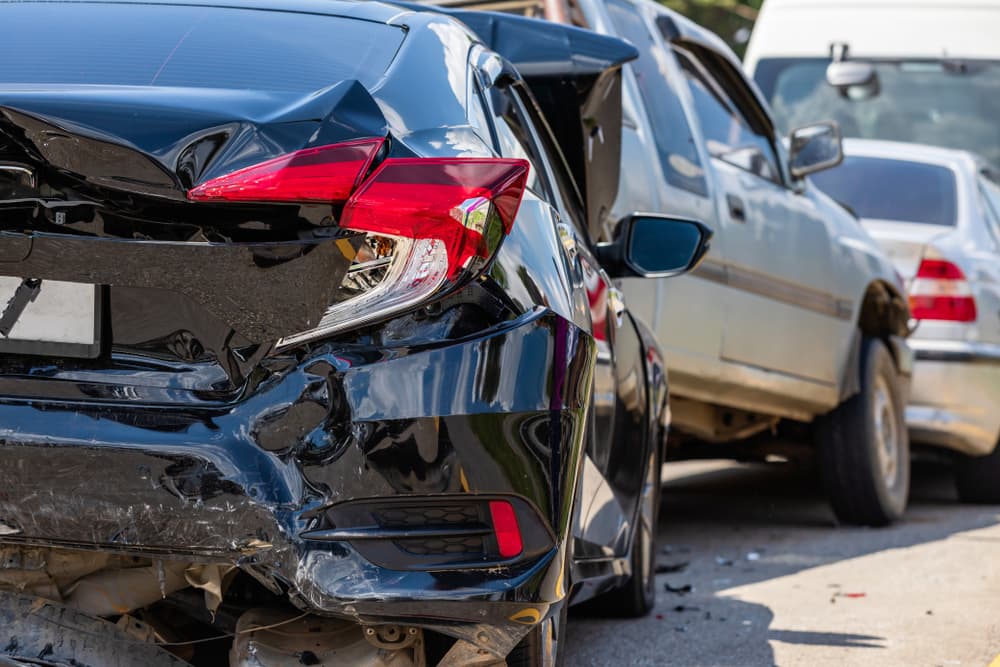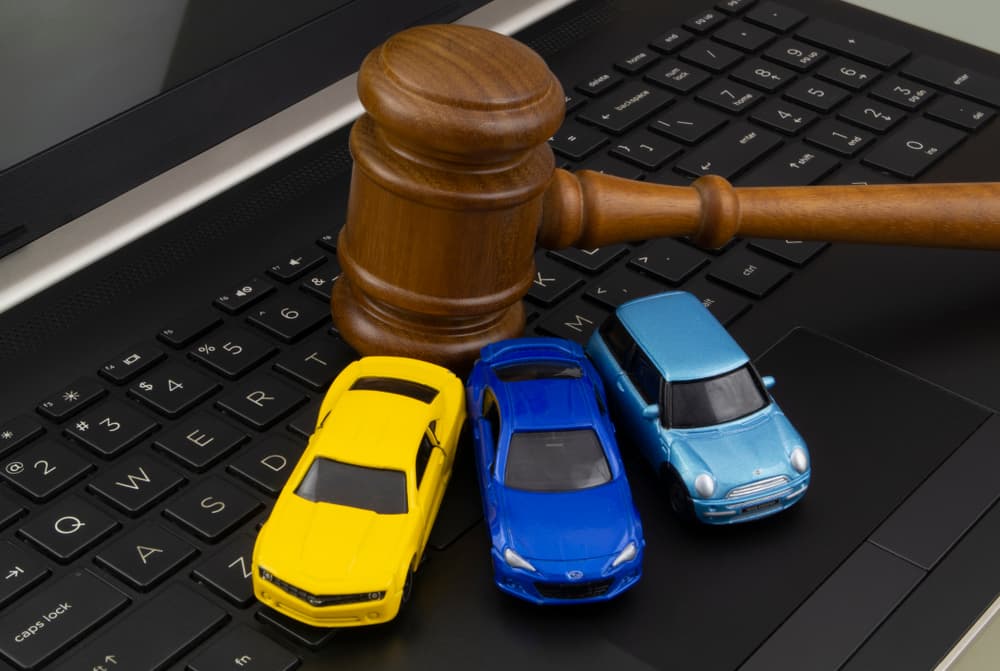Rear-end accidents are among the most common types of auto collisions. With the ever-increasing amount of traffic on freeways and roads across the country, the risk of being involved in a rear-end accident continues to increase. Whether you are a driver or passenger in the front vehicle on the receiving end of the collision or sitting in the rear vehicle, there is a potential for severe injury or damage. Knowing what to do following a rear-end accident — and determining who is at fault — can make a significant difference in how the situation plays out.
If you or a loved one has been involved in a rear-end accident, you need the help of an experienced car accident lawyer to pursue the best available outcome for your situation. With so much riding on the resolution — whether you are a victim or the at-fault party — you can’t afford to attempt to navigate the complicated legal landscape without professional guidance. A skilled attorney will explain the legal options available to you and lead you through each step of the process. Reach out to a knowledgeable rear-end accident lawyer today to schedule a consultation to discuss the details of your case and create a strategy that suits your needs.
Prevalence of Rear-End Accidents
While car accidents come in many types, rear-end collisions are one of the most frequent. Traffic safety studies have found rear-end accidents to account for a significant percentage of all traffic accidents, with many collisions resulting in property damage and physical injuries. The prevalence of rear-end collisions can be attributed to common driver behaviors such as following too closely, driving while distracted, and factors that require vehicles to make sudden stops. Lack of awareness on the part of many motorists leads to rear-end accidents, which can cause significant physical and financial challenges for the victims.
Determining Fault in a Rear-End Accident
As with any auto accident, determining fault in a rear-end collision involves various factors. While a thorough investigation by law enforcement and each party’s legal representatives may lead to a conclusive determination, there is also a chance that the parties will disagree on the assessment, leading to the necessity for further legal remedy. To correctly assign fault in a rear-end accident, police reports, witness accounts, vehicle damage, and other types of evidence will be examined. A better understanding of these variables can give you an idea of what to expect during the legal process as you work with your rear-end accident lawyer to pursue a favorable outcome.
What Is a Rear-End Accident?
As the term suggests, a rear-end accident occurs when one vehicle is struck in its rear end by another vehicle. Heavy traffic, busy intersections, distractions, or objects in the roadway can cause sudden decelerations, creating situations where rear-end accidents are commonplace. Though some rear-end accidents may be relatively minor, others can result in severe injuries and substantial damage to one or both vehicles; whether your accident was a fender bender or a more severe crash, you need to know the basics about such cases, how fault is determined, and the impact such an accident can have from an insurance or legal point of view.
Common Scenarios for Rear-End Accidents

Rear-end accidents can occur in a wide range of driving scenarios, with many instances resulting from driver inattention or sudden changes in traffic flow at any given moment. Some of the more common scenarios of rear-end collisions include:
- Heavy Traffic: Bumper-to-bumper conditions, with frequent starts and stops, increase the risk of rear-end accidents.
- Distracted Driving: Drivers using cell phones, eating, or engaging in other activities can significantly affect reaction time.
- Sudden Stops: Unexpected braking by vehicles ahead due to obstacles or other factors can create situations in which other vehicles are unable to avoid collisions.
- Inclement Weather: Slick roadways due to rain, snow, or ice make driving in traffic more hazardous.
- Following Too Closely: Tailgating significantly reduces the amount of time and distance vehicles need to stop safely.
Regardless of the cause of the accident, determining fault is one of the most critical aspects of the ensuing legal process.
General Rule of Fault in Rear-End Collisions
In rear-end accidents, the responsibility for the collision is often placed on the driver of the rear vehicle. This is the case despite multiple factors that can lead to the fault being placed elsewhere. This section will cover why fault in rear-end collisions is generally assigned to the rear vehicle, potential exceptions to this rule, and shared fault scenarios. This information can give you a better understanding of how fault can be determined in your rear-end accident and possible scenarios that may arise throughout the legal process.
Presumption of Fault for Rear Vehicle
There are multiple reasons why the assignment of fault in rear-end collisions generally falls on the driver of the rear vehicle. Some of the common reasons for this include the driver’s need to:
- Follow at a Safe Distance: All drivers are expected to maintain a reasonable distance between their cars and the vehicles ahead of them to provide enough time and distance to stop safely.
- Exercise Vigilance: Drivers are responsible for staying alert and attentive while operating vehicles to react to sudden changes.
- Maintain Control: A driver is responsible for maintaining control of their vehicle, including its maneuvering and speed, to avoid potential accidents.
While the presumption of fault on behalf of the rear vehicle’s driver generally holds true, there are certain circumstances under which the fault for the accident may shift or be shared.
Exceptions to General Rules
Though the operator of the rear vehicle is typically presumed to be at fault for a rear-end accident, there are some notable exceptions to this general rule, leading to another party potentially being held responsible. Some of these exceptions include:
- Sudden & Unpredictable Stops: If the lead vehicle stops abruptly without reason, there may be little chance for the trailing vehicle to stop safely.
- Unexpected Reversing: If the front vehicle begins moving in reverse without warning, there can be little the rear vehicle can do to avoid an accident.
- Inoperable Brake Lights: If the brake lights of the lead vehicle are not functioning, the driver of the rear vehicle may not receive any visual signal that the lead vehicle is slowing or stopping.
In cases like those listed above, the fault for the rear-end accident may shift to another party or be shared by multiple parties, depending on the situation’s specifics.
Evidence Used to Determine Fault
Determining fault in a rear-end collision can involve a wide range of evidence. Some of the critical pieces of evidence in such an accident include:
- Law Enforcement Reports: Official documentation of the accident scene and the parties involved.
- Witness Testimonies: Recorded statements from people who saw the accident take place.
- Dashcam & Surveillance Video: Footage capturing the accident scene before and after the car collision.
- Vehicle Damage: Examination of damage to all vehicles involved in the accident can provide insight into the details of the collision.
- Driver & Passenger Statements: Accounts provided by individuals directly involved in the accident.
The factors listed above can help clarify the circumstances surrounding the rear-end collision and aid in accurately assigning fault.
Legal & Insurance Implications

The determination of fault in a rear-end car accident can have significant implications for both legal and insurance aspects for the principals involved. The driver found to be at fault for the accident can be confronted with increased insurance premiums and be held responsible for compensating the affected parties for damages and/or medical expenses. The at-fault party may also face citations or further legal action, depending on the specifics of the incident. Understanding these factors makes it imperative to know how fault is determined in your accident.
How Fault Impacts Insurance Claims
Determining fault weighs heavily on the insurance claims process following a rear-end car accident. The insurance provider that covers the at-fault driver will typically cover damages and medical costs for victims. As a result, the at-fault driver will experience an increase in their insurance premiums. Insurance companies will analyze the accident in detail to determine fault and the extent of damages. Having an experienced car accident lawyer in your corner can help you navigate the insurance claims process to ensure your rights are protected.
How Fault Impacts Potential Compensation for Damages & Injuries
Fault determination in a rear-end collision directly influences compensation for the affected parties for property damage and medical expenses. The at-fault driver’s insurance provider will cover repair costs and medical bills. In cases of shared fault, compensation will be adjusted accordingly based on each party’s percentage of fault. Accurate fault assessment can help ensure that injured parties receive fair compensation. Outside of insurance coverage, an at-fault party may face additional out-of-pocket expenses not covered by their insurance policies. In the aftermath of such an accident, your lawyer can help determine the best action to seek the compensation you deserve.
Possible Legal Consequences
Depending on the specific circumstances of a rear-end car accident, an at-fault driver can face a variety of legal consequences, including:
- Traffic Citations: A driver responsible for a rear-end accident may be ticketed for violations such as following too closely or driving distracted.
- Fines & Penalties: The responsible party may face accompanying financial penalties along with traffic citations.
- Increased Insurance Premiums: Being at fault for an accident can increase insurance rates.
- Lawsuits: Injured parties may file civil suits to seek damages and compensation for medical costs.
- Driver’s License Points: Accumulating points on a driving record can eventually lead to suspension.
Understanding the consequences listed above emphasizes the importance of not only knowing what to do in the aftermath of a rear-end collision but also the necessity of working with an experienced car accident attorney.
Why You Need an Attorney

As with any traffic accident, navigating the complex landscape following a rear-end collision requires a highly trained and experienced professional to lead the way. A knowledgeable car accident attorney can assist in a variety of ways, including:
- Evidence Collection: A lawyer has experience in gathering and organizing evidence.
- Negotiation Skills: Dealing with insurance companies and other legal parties is complex.
- Litigation Representation: Representation in all court proceedings.
- Maximizing Compensation: Following your accident, you deserve fair compensation.
With a skilled lawyer, you can feel confident that your case will be in good hands and you will have the best chance of achieving the desired outcome. If you have been involved in a rear-end accident, you should always have an attorney on your side. Rear-end accidents can result in serious injuries and property damage, and navigating the legal process can be complex and overwhelming. Additionally, an attorney can help you determine who is at fault in a rear-end accident.
Trust an Experienced Rear-End Accident Lawyer for Help
If you have been involved in a rear-end collision, you may be dealing with a wide range of serious issues, including physical pain, mounting medical bills, property damage, and all of the stress and emotional turmoil that comes along with such a trying situation. Rather than go through these challenges alone, your best option is to contact a knowledgeable legal professional for assistance. Facing a complicated legal matter without the right advocate in your corner can leave you at risk of failing to obtain the outcome you and your family need.
Fortunately, there is skilled help available. Working with an attorney with extensive experience handling rear-end accident cases gives you peace of mind that your best interests will be represented and your rights will be protected during every stage of the process. Though rear-end collisions may sometimes seem relatively minor at the time of the accident, significant and long-term injuries can result. With a personal injury lawyer on your side, you can work toward obtaining the outcome you need, including fair financial compensation to pay your medical bills and cover for lost income if you are unable to work and repair or replace your damaged vehicle. Don’t delay, contact an experienced rear-end accident attorney today to schedule a consultation to discuss your case.